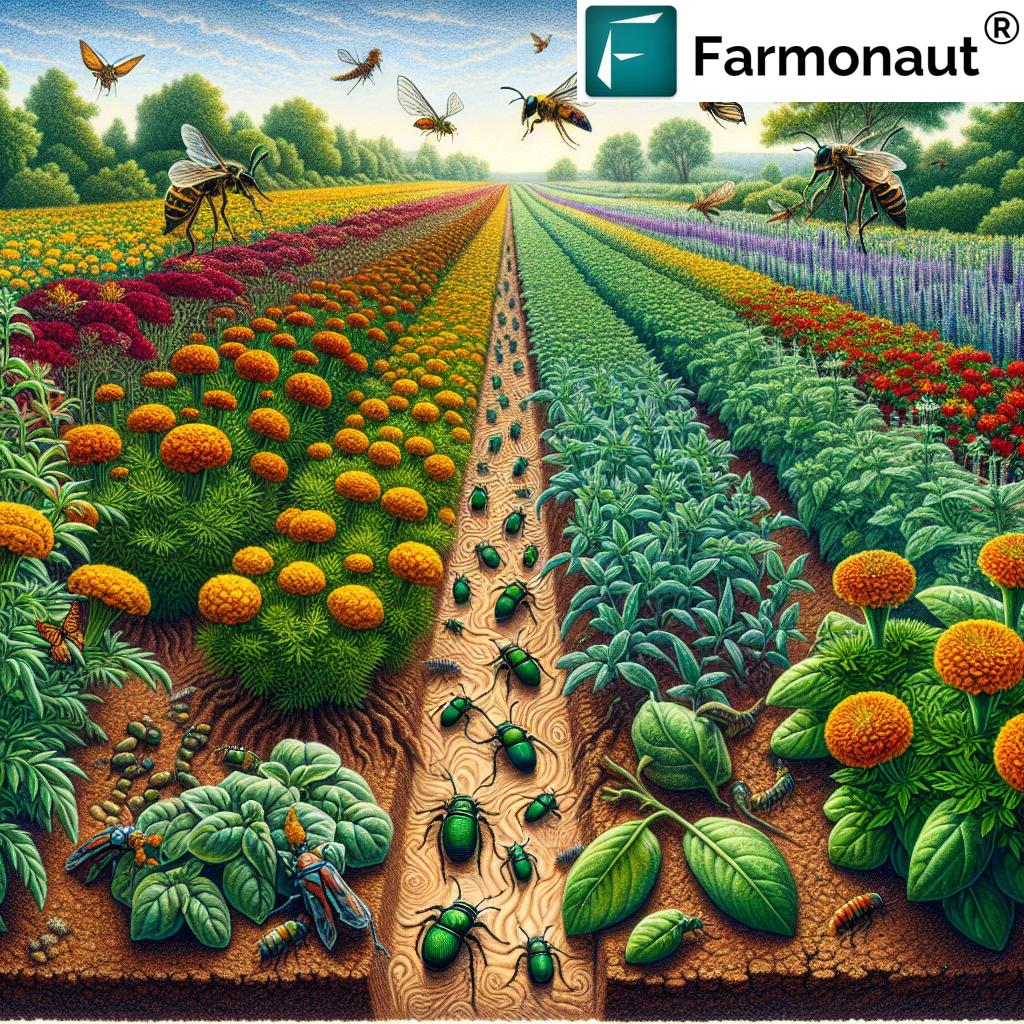Bacterial Blight in Cotton: Top 7 Control Techniques (2025 Guide)
- Introduction: The Ongoing Challenge of Bacterial Blight in Cotton
- Understanding Bacterial Blight in Cotton
- Advances in Detection & Diagnosis (2025)
- Top 7 Bacterial Blight Control Techniques in Cotton (2025)
- Comparison Table: Bacterial Blight Control Techniques in Cotton
- Innovations in Bacterial Blight Management: Technology & Future Prospects
- FAQ: Bacterial Blight in Cotton
- Conclusion: Safeguarding Cotton Yields in 2025 and Beyond
“Bacterial blight can reduce cotton yields by up to 30% if not managed with effective control techniques.”
Introduction: The Ongoing Challenge of Bacterial Blight in Cotton
Cotton, one of the most vital fiber crops globally, remains the backbone of the textile industry—underpinning the livelihoods of millions of farmers and contributing significantly to the economies of many warm, humid regions. Although cotton continues to fuel countless industries, bacterial blight in cotton—caused primarily by the pathogen Xanthomonas citri pv. malvacearum—remains a significant challenge to yield, crop sustainability, and agricultural profitability.
In 2025, the pressures of climate change, monocropping, increased humidity, and persistent pathogen strains have made bacterial blight more formidable than ever before. As a primary disease threatening cotton production, it affects nearly every stage, from seed to harvest, jeopardizing the staple fiber’s quality and the well-being of those who rely on it.
This comprehensive guide addresses the evolving threat of bacterial blight in cotton by diving deep into the top 7 control techniques for 2025, informed by the latest research and designed to help farmers, agronomists, and policy-makers safeguard their crops and yields. Whether you manage single cotton fields, large agricultural operations, or support others in the industry, understanding these strategies is critical to cotton sustainability and global food security.
Understanding Bacterial Blight in Cotton
What is Bacterial Blight?
Bacterial blight in cotton, often termed “angular leaf spot,” is a destructive crop disease caused primarily by the pathogen Xanthomonas citri pv. malvacearum. It affects all aerial parts of the plant, triggering epidemics in cotton-growing regions with warm temperatures and extended periods of high humidity.
- Pathogen: Xanthomonas citri pv. malvacearum
- Crops Affected: Mainly cotton, but some related species can carry the bacterial agent as alternate hosts.
- Conditions Favoring Disease: Humid, rainy, and warm climates; dense plantings; monoculture systems.
Symptoms of Bacterial Blight in Cotton
Bacterial blight manifests in cotton through a let of recognizable symptoms, which can appear from the early seedling stage to boll formation:
- Water-soaked lesions on leaves (initially small and round, becoming angular over time).
- Angular leaf spots bounded by veins, which may turn brown and necrotic.
- Defoliation during severe infections, exposing bolls to sunburn and pests.
- Boll rot, damaging fiber quality and yield output.
- Black arm symptom—dark, elongated lesions on stems and petioles—sometimes leading to stem breakage.
- Reduced photosynthetic capacity due to leaf area loss, ultimately compromising plant development and boll formation.
The impact of this blight on cotton production is stark; even substantial losses (up to 30% yield reduction) can lead to economic deprivation for farmers and a weakened cotton supply chain, especially during epidemic outbreaks.
Life Cycle and Spread of the Pathogen
The bacterial pathogen can survive season to season in:
- Seed coats and internal tissues
- Crop residues left in the field
- Alternate host plants (weeds, wild relatives)
Xanthomonas can persist in the soil or residues when infected plant material is not destroyed. The organism is scattered by rain splash, irrigation water, insects, farm machinery, and planting of infected or poorly certified seeds. Favorable weather—namely increased rainfall and humidity—amplifies the risk, fostering disease proliferation.
Why Has Bacterial Blight Become More Prevalent?
- Changing climatic patterns: More frequent extreme rainfall and unpredictable humidity promote rapid bacterial spread.
- Intensification of cotton monoculture: Limits crop rotation, allowing the pathogen to persist and evolve virulent strains.
- Poor residue management: Leaves sources of inoculum for future seasons.
- Lack of disease awareness: Limited training on early detection and control among farmers in many developing regions.
Addressing these challenges demands a blend of improved detection, advanced control techniques, and sustainable management.
Advances in Detection & Diagnosis (2025)
The 2025 landscape for disease detection hinges on rapid response—the earlier the detection, the more effective the management outcomes.
- Molecular diagnostics: qPCR (quantitative PCR) and LAMP (loop-mediated isothermal amplification) have improved identification of Xanthomonas long before visual symptoms, even at low bacterial loads. These technologies allow for detection in seeds, leaves, and debris, facilitating early intervention.
-
Satellite & Remote Sensing: Satellite imagery linked with AI-powered platforms (such as the Farmonaut Jeevn AI system) can monitor vegetation health, detect patterns of defoliation, and guide targeted interventions.
Our real-time monitoring services provide actionable insights for swift, evidence-based decision-making.

“Early detection methods decrease bacterial blight spread in cotton fields by approximately 40%, enhancing crop resilience.”
Rapid detection with these advanced techniques reduce disease spread and enhance the resilience of cotton crops—making it a critical step in integrated disease management.
Top 7 Bacterial Blight Control Techniques in Cotton (2025)
Adopting integrated disease management (IDM) is vital for sustainable blight control in cotton. Here are the seven most effective strategies to manage bacterial blight in cotton for 2025 and beyond:
1. Use of Bacterial Blight-Resistant Cotton Cultivars
The deployment of resistant cultivars forms the backbone of sustainable bacterial blight management:
- Breeding programs—using traditional methods, genomic selection, and CRISPR-based editing—now offer robust lines with multiple resistance genes.
- Advanced cultivars are developed for higher yield, fiber quality, and adaptation to regional climatic challenges.
- Continuous research on the durability of resistance guards against evolving Xanthomonas strains.
- Benefits: Durable control, reduced input costs, environmental safety, and ease of adoption by farmers.
- Limitations: Potential for resistance breakdown due to new strains; need for regional adaptation of cultivar selection.
2. Certified Disease-Free Seed and Innovative Seed Treatments
Contaminated seed is a prime conduit for blight introduction. In 2025:
- Strict regulations and certification programs enforce the use of pathogen-free seed.
- Seed treatments have advanced to include:
- Bactericidal compounds (carefully regulated for safety and sustainability)
- Bio-based agents such as plant growth-promoting rhizobacteria (PGPRs) that inhibit Xanthomonas
- Farmonaut’s blockchain-based product traceability solutions (learn more about our traceability platform) can further ensure the authenticity, origin, and health status of seeds throughout the supply chain.
- Benefits: Reduces primary infection source; lowers blight incidence at the outset.
- Limitations: Additional costs; rigorous monitoring required for widespread compliance.
3. Strategic Cultural and Agronomic Practices
Enhancing field hygiene and optimizing cotton growth conditions disrupts the blight life cycle:
- Crop rotation: Alternating cotton with non-host crops reduces pathogen carryover.
- Residue management: Removing or destroying infected plant material minimizes survival niches.
- Optimized planting dates: Reducing exposure to periods of high humidity curtails infection peaks.
- Irrigation management: Avoiding moisture on leaves through drip systems and refraining from overwatering minimizes bacterial proliferation.
- Field sanitation: Sanitizing implements and controlling volunteer cotton plants/alternate hosts.
- Our large-scale farm management tools can help monitor and optimize these operations efficiently via our satellite dashboard for real-time advisories.
- Benefits: Integrated with regular farm operations; improves overall plant health and yield.
- Limitations: Labor-intensive for smallholders; efficacy depends on widespread adoption regionally.
4. Real-Time Disease Monitoring, Early Warning, & AI-Based Advisory
Leveraging technology is pivotal in early detection and targeted management:
- Satellite-driven crop health indices (NDVI, EVI, etc.) pinpoint suspect blight zones for quick field confirmation.
- Our Farmonaut Jeevn AI Advisory System delivers precision notifications, weather-based risk forecasts, and management protocols. This functionality streamlines the fight against cotton bacterial diseases, offering actionable insights for every stage.
- Accessible via web, Android, and iOS apps—ideal for smallholder and commercial farmers alike.
- Customizable fleet and resource tracking tools (fleet management for machinery/logistics optimization) directly contribute to efficient management of blight response teams and agronomic operations.
- Benefits: Proactive, data-driven management; better targeting of treatments and field scouting; minimizes pesticide/Bactericide use.
- Limitations: Initial learning curve; requires basic digital infrastructure.
5. Biological Control Agents & Microbiome Engineering
A shift is underway toward biological management approaches:
- Antagonistic bacteria (Bacillus subtilis, Pseudomonas fluorescens) and their metabolites are increasingly used as field sprays and seed treatments. They outcompete or inhibit Xanthomonas citri proliferation.
- Research into phyllosphere microbiome engineering—fostering beneficial bacteria populations on leaf surfaces—shows promise for longer-term disease suppression.
- Biocontrols can be integrated with other IPM measures, aligning with sustainable, environmental best practices.
- Benefits: Environmentally friendly, reduces chemical application, aligns with global sustainability goals.
- Limitations: May require re-application; efficacy varies by region and environmental condition.
6. Judicious Use of Chemical Bactericides (Where Legally Permissible)
Owing to the development of resistance and environmental issues, chemical bactericides should be reserved for high-risk, targeted interventions:
- Copper-based compounds and modern, lower-toxicity materials applied only when necessary and as per legal guidelines.
- Combination with surfactants and plant health boosters may enhance field efficacy.
- Rotation of compounds is advised to mitigate resistance development in Xanthomonas populations.
- Benefits: Rapid suppression of outbreaks when integrated judiciously with other controls.
- Limitations: Potential for resistance, environmental load, and regulatory/phytosanitary restrictions.
7. Farmer Training, Extension Services, and Policy Support
Farmer awareness is foundational to real progress in bacterial blight control:
- Capacity-building workshops on early detection, symptom recognition, and IDM.
- Distribution of updated disease scouting guides and real-time alerts via digital platforms.
- Support for smallholders to access crop insurance for climate/disease risk management (Farmonaut’s verification-supported insurance systems offer robust risk mitigation for blight-prone crops).
- Public policies should incentivize rotating crops, manual sanitation, and investment in research and new technologies.
- Benefits: Empowers growers to take preventative action; ensures last-mile delivery of sustainable solutions.
- Limitations: Relies on committed governmental and NGO support.
Explore our Carbon Footprinting Tool – Track the environmental impact of your cotton operations efficiently, supporting sustainable blight management and regulatory compliance.
Access actionable crop health and disease monitoring data via our robust Farmonaut API – enhance your agri-management stack today!
Build your own custom disease response and field management solutions with our Farmonaut Developer Docs.
Comparison Table: Bacterial Blight Control Techniques in Cotton
| Control Technique | Estimated Effectiveness (% Control) | Application Method | Recommended Timing | Cost Estimate | Environmental Impact | Suitability for Resistant Cultivars |
|---|---|---|---|---|---|---|
| Resistant Cultivars | 70-90% | Planting selection | Sowing | Low-Medium | Low | Yes |
| Disease-Free Seed & Seed Treatments | 60-75% | Certified seed, chemical/biological soak | Pre-sowing | Medium | Medium | Yes |
| Cultural & Agronomic Practices | 40-60% | Rotation, residue removal, timing | Year-round | Low | Low | Yes |
| Satellite Monitoring & Advisory AI | 30-50% (as an enabling tool) | Remote sensing, app-based alerts | Continuous | Low-Medium | Low | Yes |
| Biological Control Agents | 40-65% | Seed treatment, foliar sprays | Sowing, vegetative growth | Medium | Low | Yes |
| Chemical Bactericides | 30-60% | Foliar sprays | At-disease outbreak | Medium-High | Medium-High | Yes |
| Farmer Training & Extension | 20-40% (as an enabler) | Workshops, guides, digital alerts | Continuous | Medium | Low | Yes |
Innovations in Bacterial Blight Management: Technology & Future Prospects
Bacterial blight in cotton is not simply a farm-level dilemma—it’s a global agricultural challenge demanding innovation on multiple levels. Let’s explore the pivotal roles of advanced technology, research, and sustainability initiatives:
1. Harnessing the Power of Remote Sensing & AI
- Farmonaut’s satellite-based crop monitoring delivers actionable insights for cotton bacterial diseases via our AI-powered dashboards, streamlining detection of health anomalies, residue management, and growth pattern irregularities.
- Integrating real-time weather data, historical disease patterns, and NDVI analytics ensures field scouts and managers can act at the first sign of blight.
Start using Farmonaut for field-level, data-driven crop protection and advisory.
2. Blockchain-Backed Traceability
- Blockchain technology, as offered by Farmonaut product traceability, guarantees transparency in seed origin, disease testing, and supply chain movement—reducing the risk of infected seed reaching market.
- End-to-end traceability builds trust with stakeholders and enhances market value for sustainably managed cotton.
3. Focused R&D: Microbiome Engineering & Advanced Breeding
- International research is racing to characterize the microbiome of healthy cotton, engineering the phyllosphere to naturally suppress Xanthomonas populations.
- Biotech-driven breeding programs continue to develop cultivars with stacked resistance—a sustainable answer to evolving pathogen populations.
4. Environmental Impact Monitoring & Carbon Tracking
- With sustainability a non-negotiable in 2025, Farmonaut’s carbon footprinting solutions support responsible deployment of inputs, minimizing overall environmental impact from antibacterial treatments and field operations.
- These tools let estate managers and corporations show compliance with strict international norms while optimizing their profitability and sustainability.
Farmonaut Subscription Plans
Ready to upgrade your agricultural insights, optimize yields, and ensure sustainable field practices?
Choose a Farmonaut subscription that fits your workflow:
5. Financing, Insurance, and Resource Optimization
- Satellite-based crop loan and insurance verification ensures only healthy, well-managed cotton fields are insured—reducing risk for both growers and providers.
- Fleet management solutions help large farms allocate manpower and machinery with efficiency—crucial for timely blight interventions.
FAQ: Bacterial Blight in Cotton
-
What causes bacterial blight in cotton?
Bacterial blight in cotton is caused by the pathogen Xanthomonas citri pv. malvacearum. The disease is spread primarily through infected seed, crop residues, and sometimes water, insects, and equipment. -
What are the key symptoms of bacterial blight in cotton?
The disease manifests as angular leaf spots, water-soaked lesions, defoliation, and sometimes stem lesions (black arm) and boll rot, leading to yield and quality reduction. -
How can I detect bacterial blight early in my field?
Early detection is possible with molecular diagnostics (qPCR, LAMP). Satellite monitoring and AI advisory systems like those on the Farmonaut platform also provide real-time alerts based on crop health deviations. -
What is the most sustainable way to control bacterial blight in cotton?
Using resistant cultivars, certified seed, good sanitation, crop rotation, and adopting biological control agents are most sustainable. Integrating these with regular monitoring and farmer training ensures long-term effectiveness. -
Are chemical bactericides still effective in 2025?
Their effectiveness is limited due to developing resistance and environmental concerns. They should only be used judiciously, in combination with other management strategies, and in compliance with local regulations. -
Can Farmonaut help with bacterial blight management?
Yes—Farmonaut offers real-time field monitoring, AI-based advisory, blockchain-backed traceability, and environmental impact tracking— all accessible via app or web, supporting informed and sustainable decision-making for cotton growers.
Conclusion: Safeguarding Cotton Yields in 2025 and Beyond
Bacterial blight in cotton remains a formidable threat to crop productivity and farm incomes in 2025, particularly in regions with climatic conditions that favor Xanthomonas proliferation. However, leveraging the power of early detection, resistant cultivars, innovative seed treatments, sustainable field practices, biological agents, and real-time digital tools forms the cornerstone of successful blight control and management.
Integrated approaches—united with ongoing research and farmer education—are essential for long-term sustainability and the continued ability of the cotton textile industry to thrive. As we collectively advance towards smarter agriculture, platforms like Farmonaut will continue to enable growers and businesses globally to tackle cotton bacterial diseases in a proactive, cost-effective, and environmentally responsible manner.
Let’s work together to bolster yield reserves, protect fiber quality, and secure the livelihoods of millions who depend on healthy, productive cotton crops worldwide.











